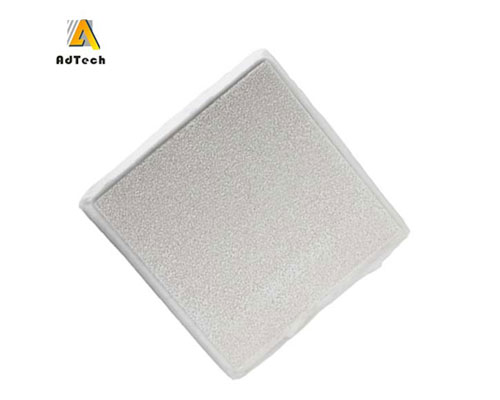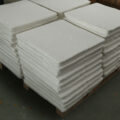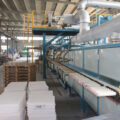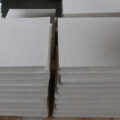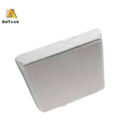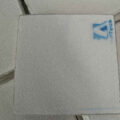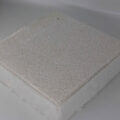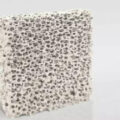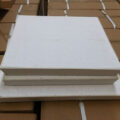Ceramic foam filter plates have an open cell structure characterized by a plurality of interconnected voids, allowing molten metal to pass therethrough for removal of entrained solids. The ceramic foam filter plate is made of sintered ceramic aggregate or porous carbon plate. The ceramic foam filter has an open pore structure, which is characterized in that a plurality of interconnected voids are surrounded by the mesh of the ceramic material. The air permeability of the ceramic filter is 400 to 8,000×10 -7 cm 2, preferably 400 to 2,500×10 -7 cm 2, the porosity or porosity is 0.80 to 0.95, and each hole is 5 to 45 linear inches of holes, preferably 20 to 45 holes per linear inch. The flow rate of molten metal through the filter should be 5 to 50 cubic inches per square inch of filtration area per minute.
The ceramic foam filter is low cost and can be used once. In addition, the filter is surprisingly effective at filtering molten metal, especially aluminum, at a low cost, thereby achieving surprising filtering efficiency and considerable flexibility.
The ceramic foam filter is made of an open-cell flexible foam material with a plurality of interconnected voids surrounded by a net of the flexible foam material, such as polyurethane foam or cellulose foam. An aqueous ceramic slurry is prepared, and the foamed material is impregnated with the foamed ceramic material, thereby coating the fiber web with it, and basically filling the voids with it. The impregnated material is compressed so that a part of the slurry is discharged from here and the rest is evenly distributed throughout the foam material. The coated foam material is then dried and heated to first burn off the flexible organic form, and then the ceramic coating is sintered, thereby providing a fused ceramic foam having a plurality of interconnected voids that are bonded or fused ceramic Surrounded by a net and foamy. Soft foam. Naturally, various ceramic materials can be selected according to the specific metal to be used, and a mixture of aluminum oxide and chromium oxide can be used.
However, these materials can of course be used alone or in combination with other ceramic materials. Other typical ceramic materials that can be used include zirconia, magnesia, titanium dioxide, silicon dioxide and mixtures thereof. Generally, the slurry contains about 10 to 40% water and one or more rheological agents, binders or air setting agents.
Ceramic foam filter plates can be conveniently used in various positions, including dumping trays, dumping troughs, transfer troughs, pouring spouts and metal processing troughs. The filter should not be placed in turbulent flow, especially in close proximity to the flow of molten metal, as such turbulence leads to the formation and entrainment of oxides. This is true for the turbulence upstream and downstream of the filter.
Accompanied by oxide entrainment, the turbulence upstream of the filter tends to cause the filter to channel flow, the filtration efficiency is low, and in severe cases, the filter will be blocked prematurely. Downstream of the turbulent flow, the filter will tend to filter well and will again be mixed with melting and oxides. Frequently encountered sources of turbulence are furnace tap holes, pouring spouts and other locations that cause rapid changes in the flow cross section.
Naturally, a particular filter installation must be carefully selected to ensure that it does not become another source of turbulence. Of course, the aforementioned turbulence considerations are particularly relevant to chemically active metals such as aluminum. Magnesium and its alloys are prone to oxidation when in contact with air; however, these considerations are also important for metals that are less reactive (such as copper and its alloys).

